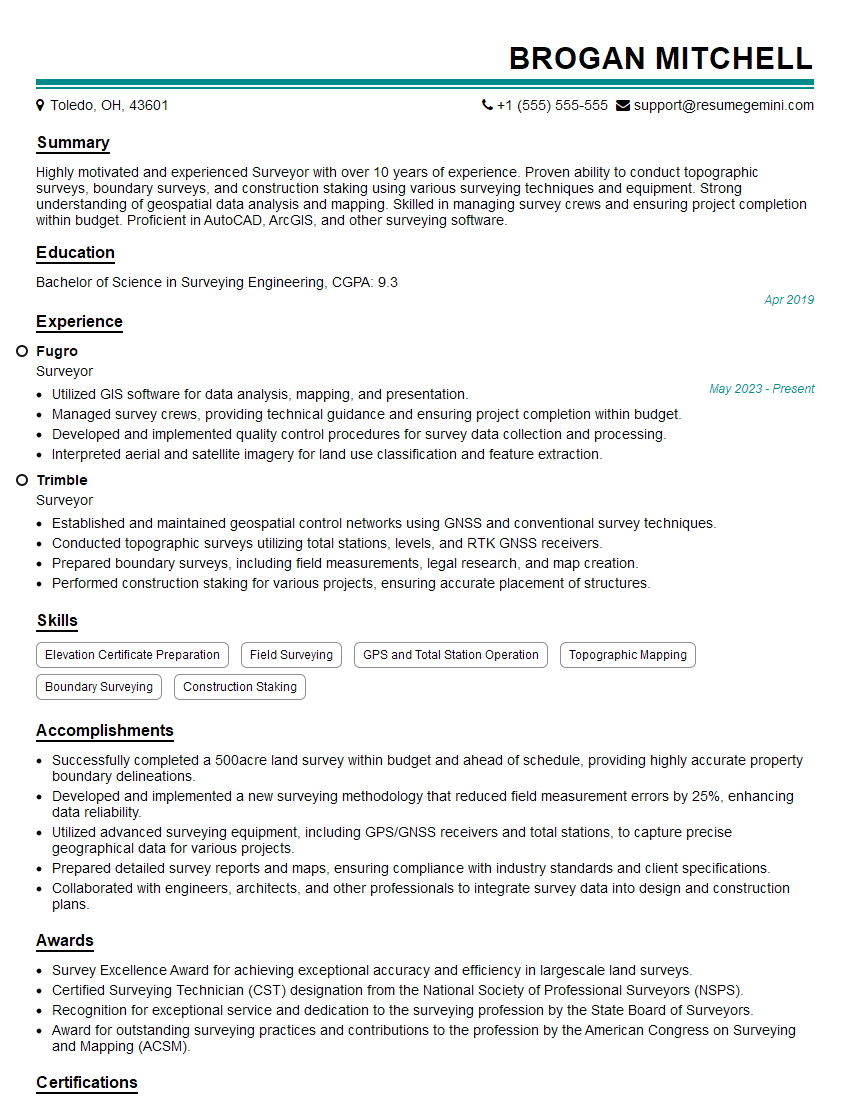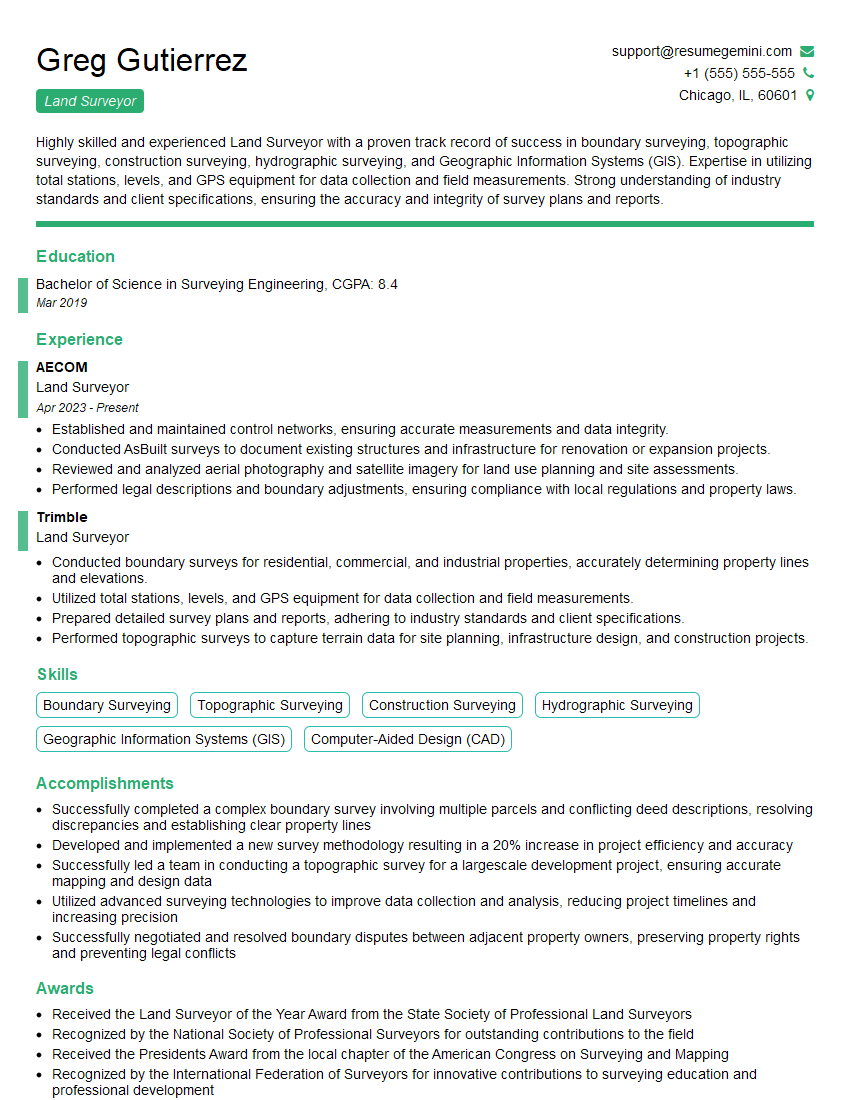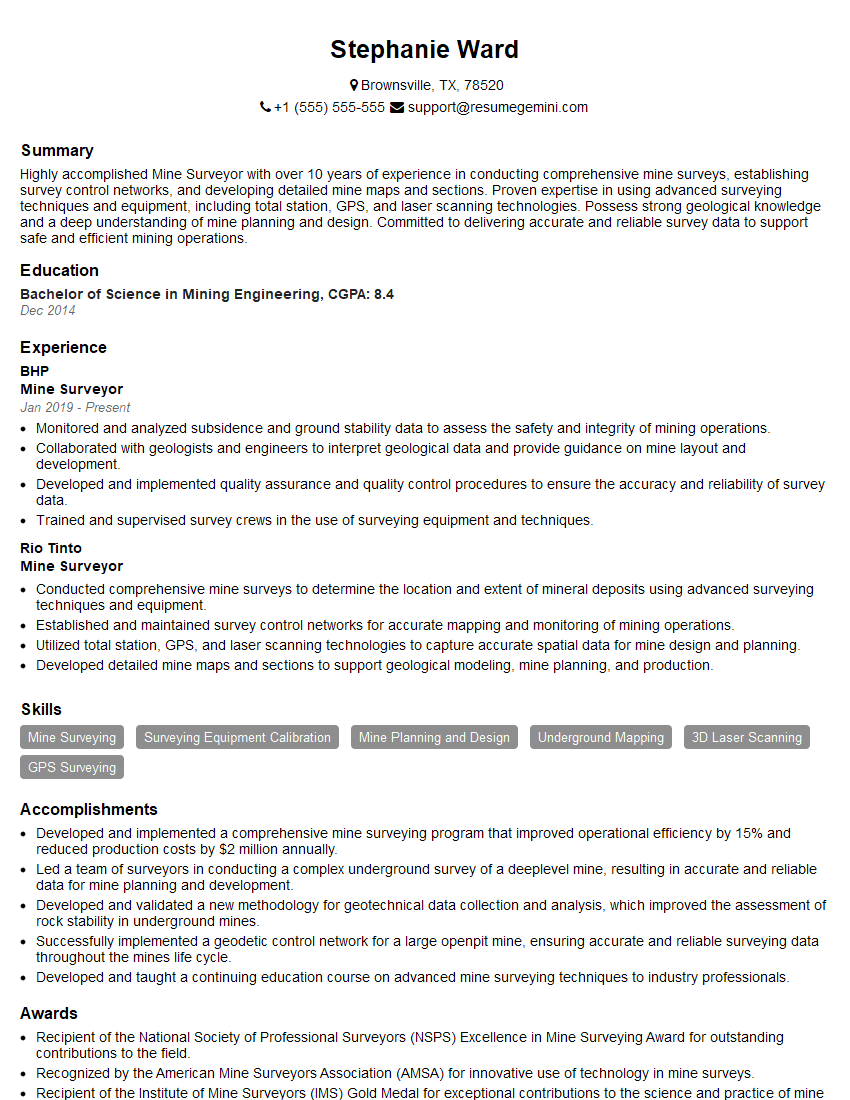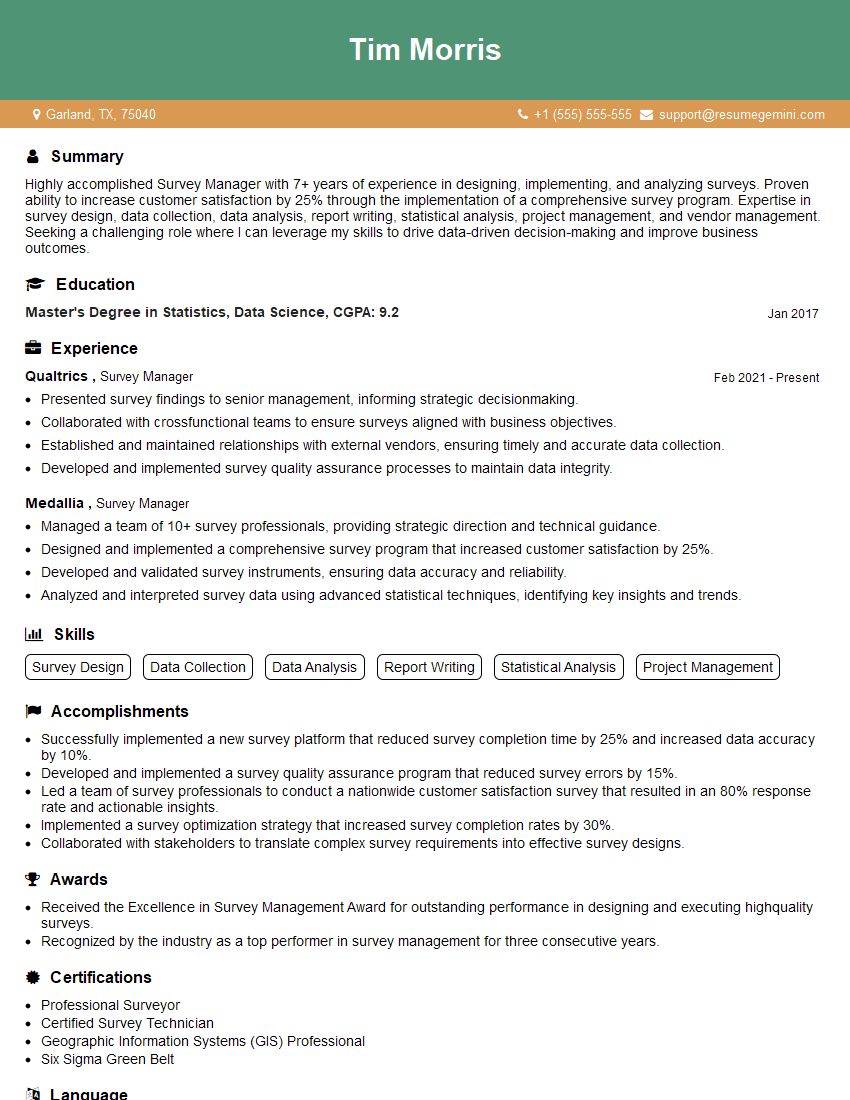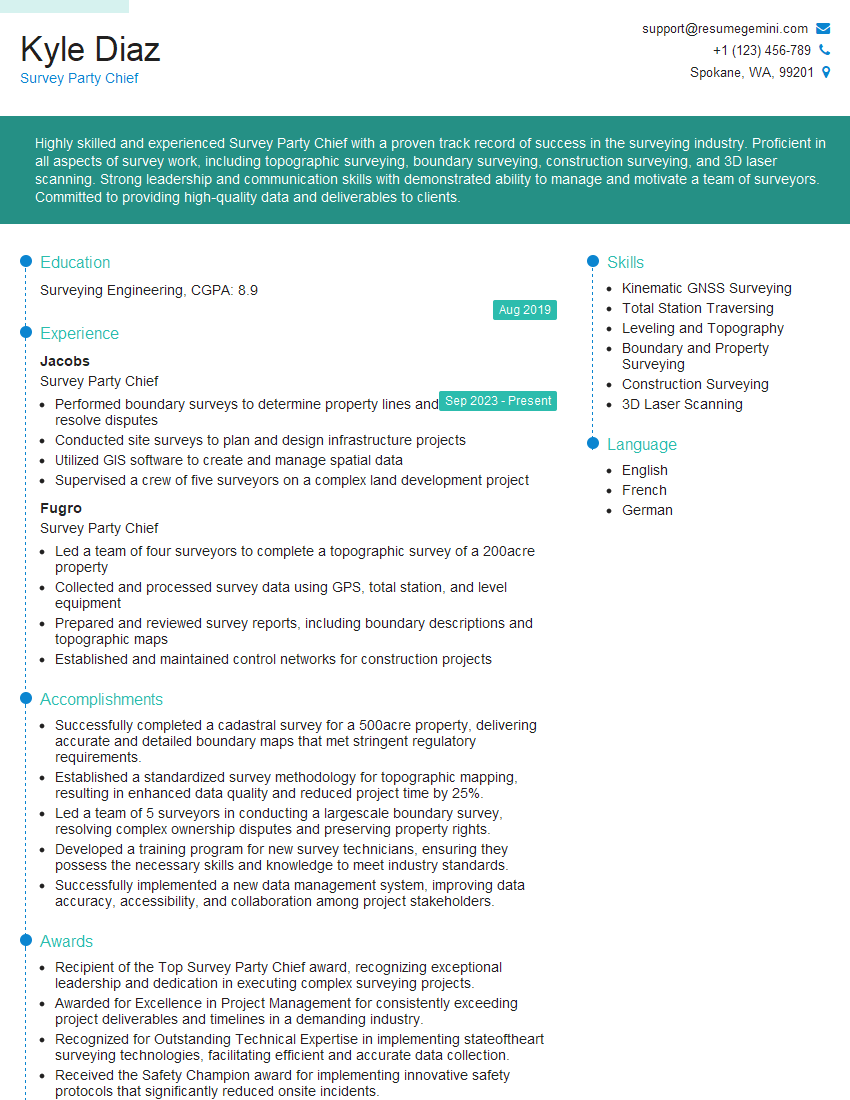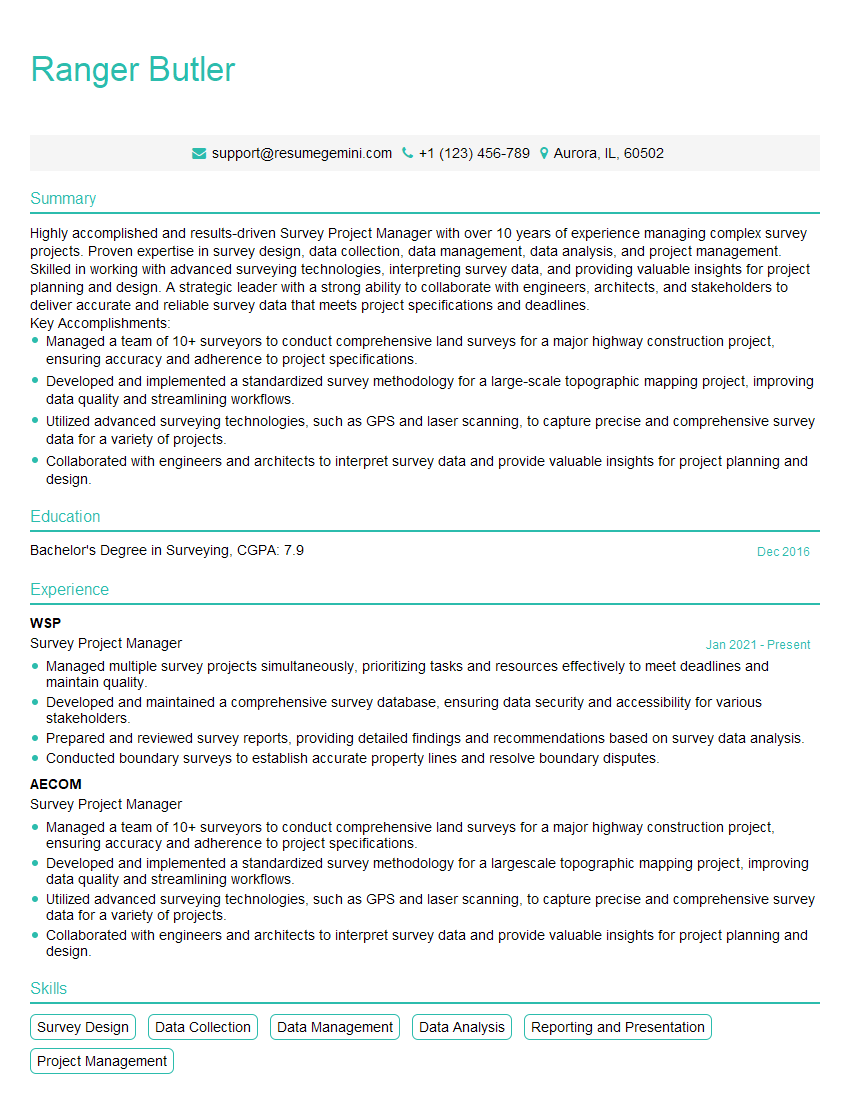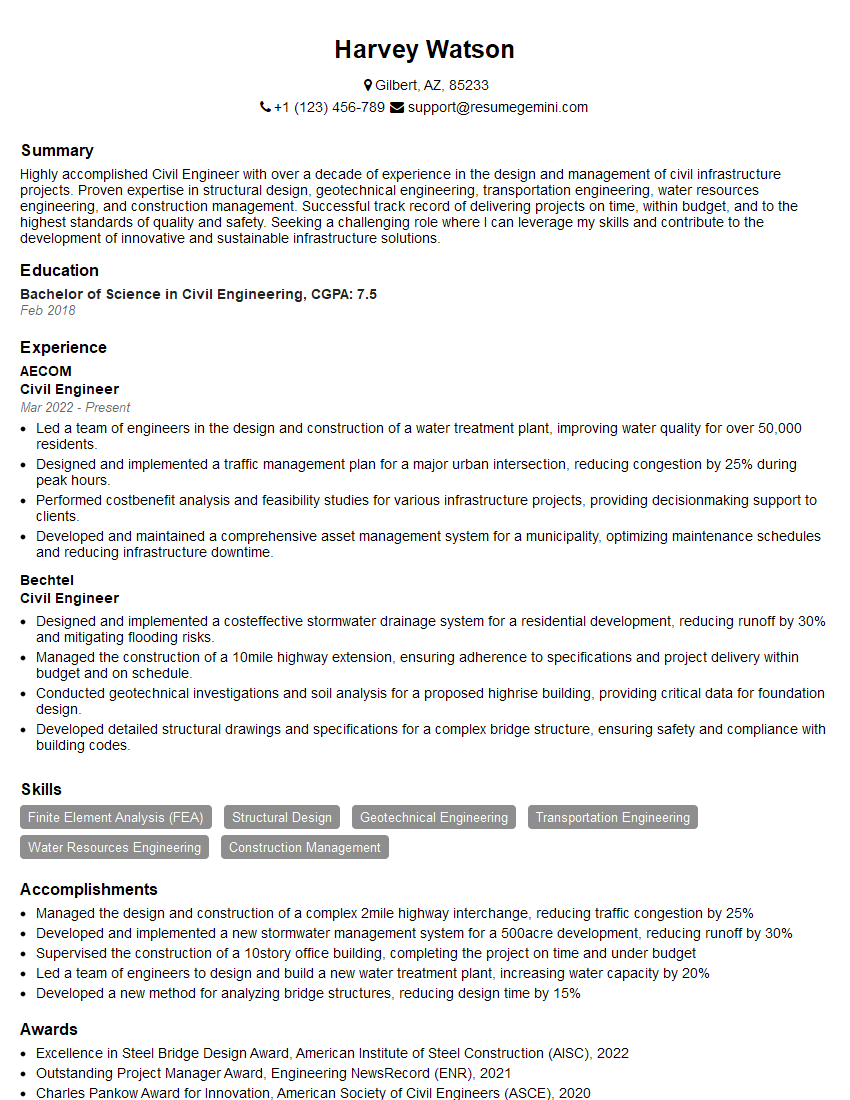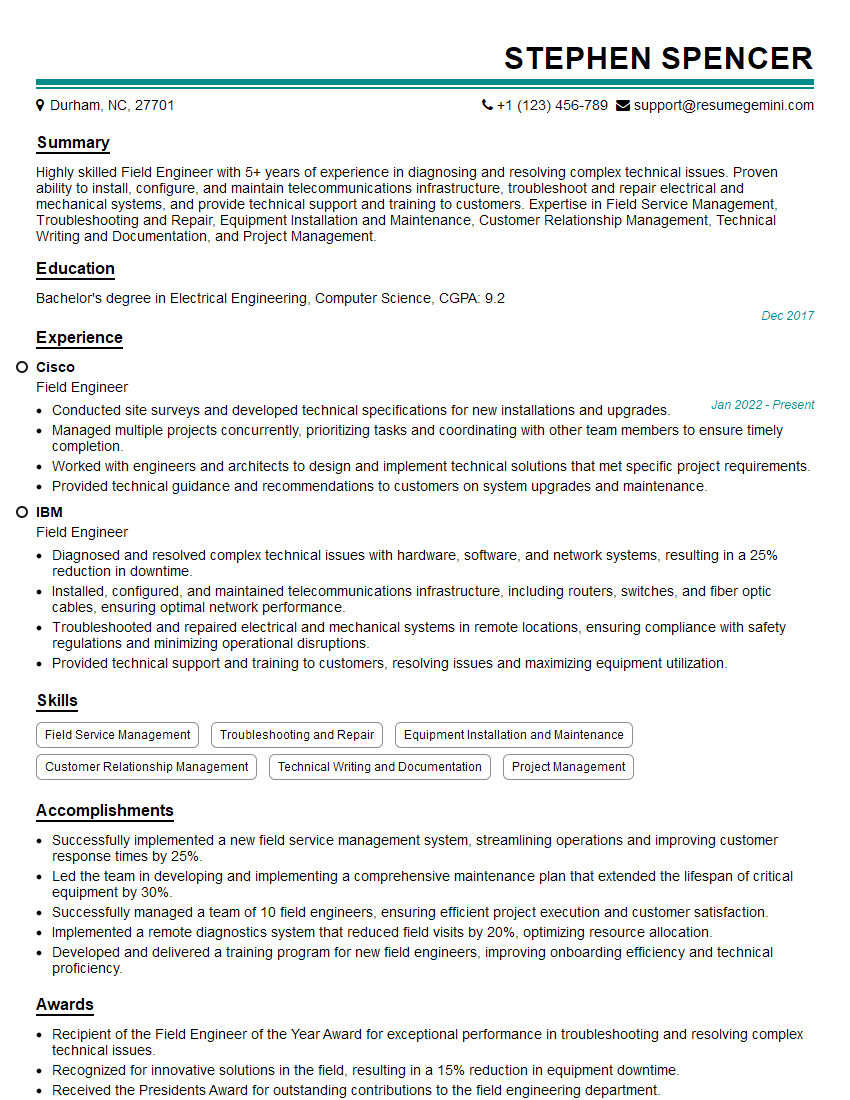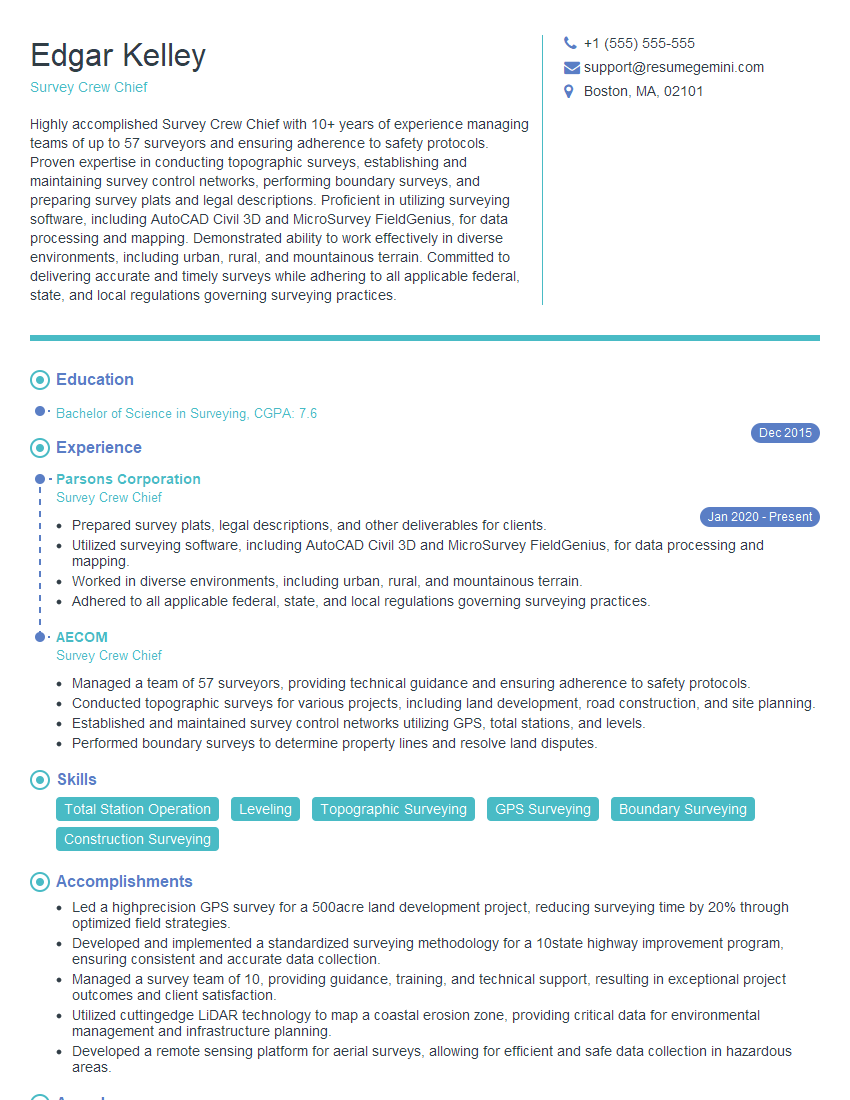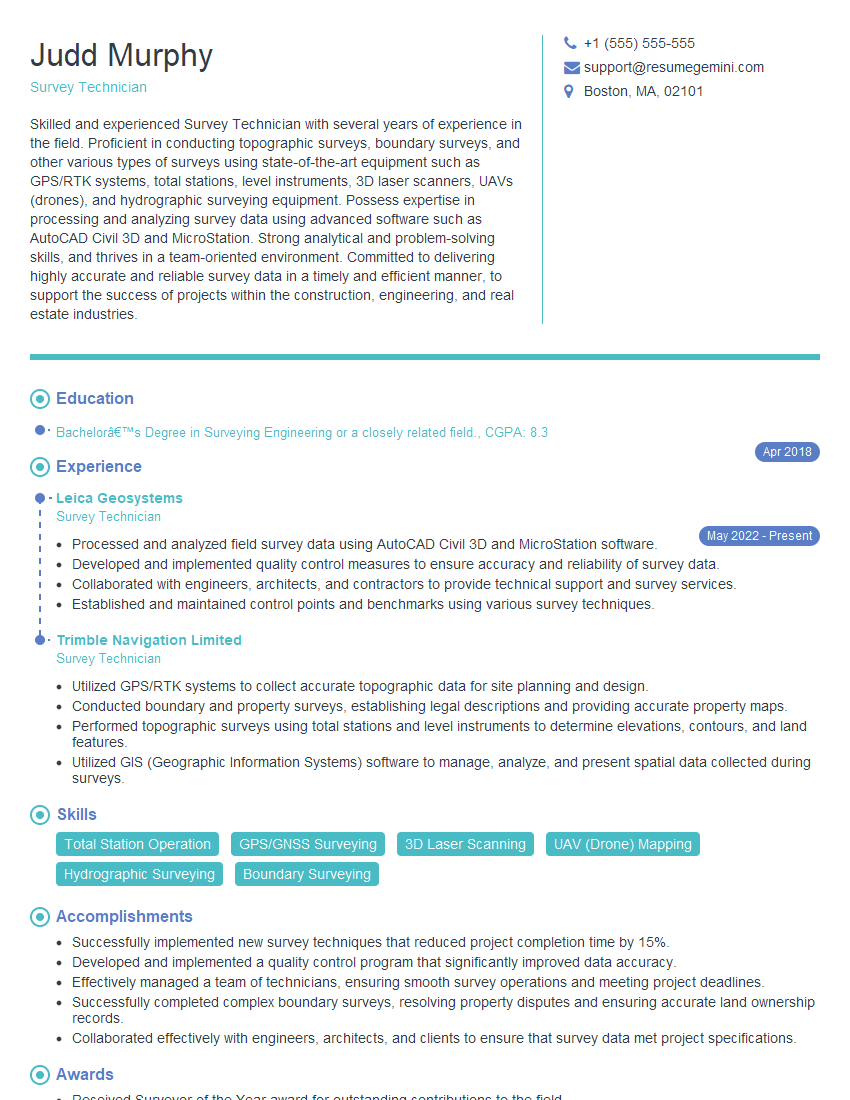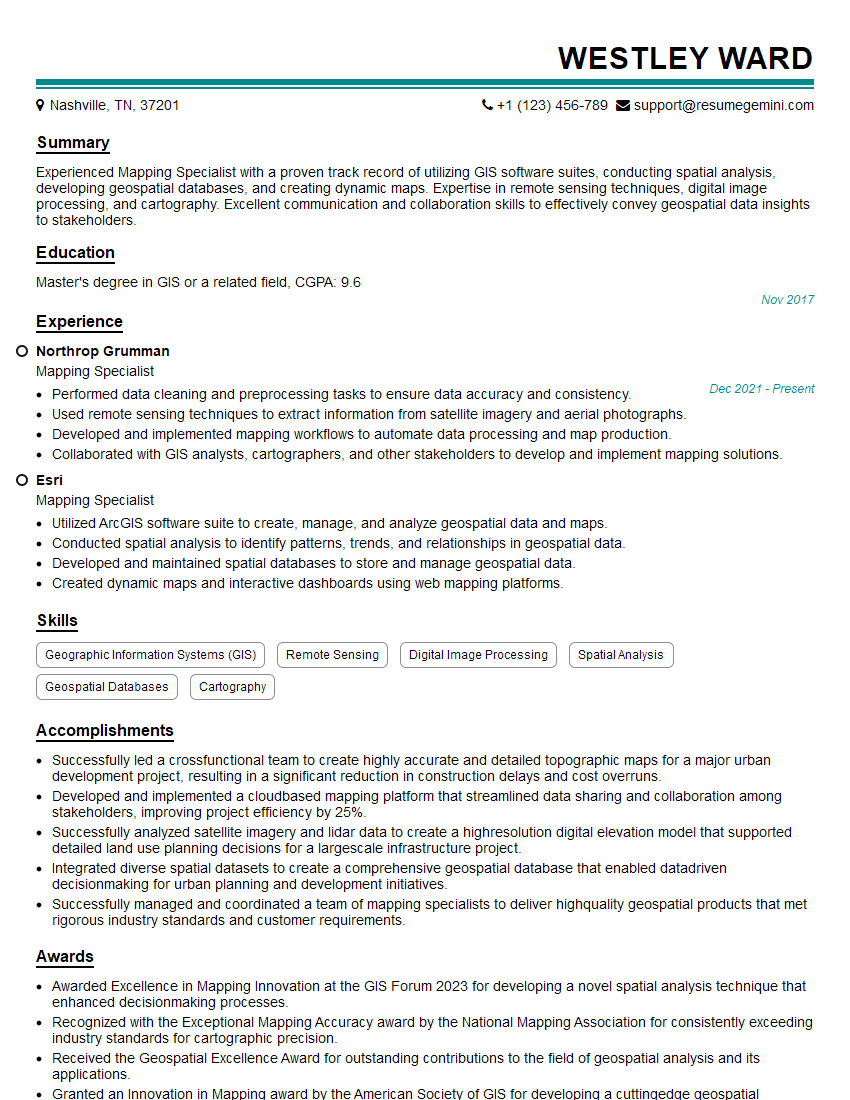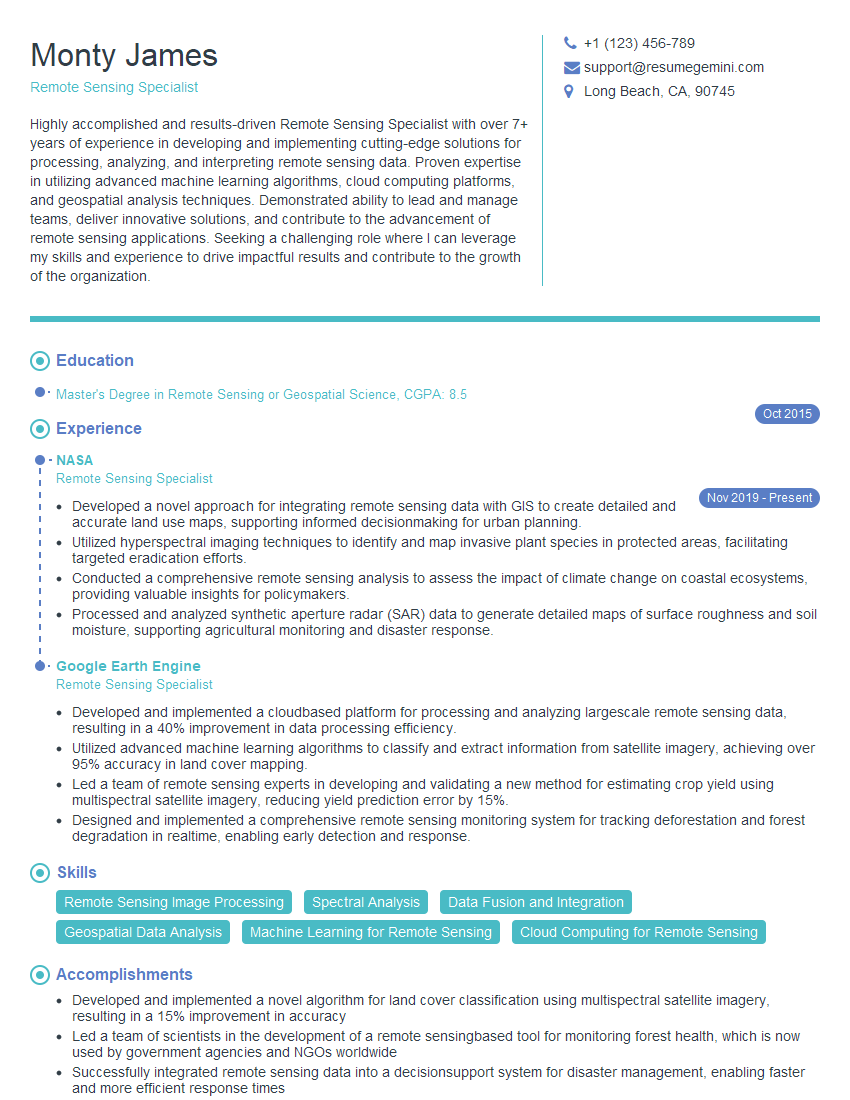Interviews are more than just a Q&A session—they’re a chance to prove your worth. This blog dives into essential Proficient in using survey-specific software, such as Carlson SurvCE interview questions and expert tips to help you align your answers with what hiring managers are looking for. Start preparing to shine!
Questions Asked in Proficient in using survey-specific software, such as Carlson SurvCE Interview
Q 1. Describe your experience using Carlson SurvCE.
My experience with Carlson SurvCE spans over eight years, encompassing a wide array of surveying projects. I’ve used it extensively for everything from basic topographic surveys to complex construction stakeouts and boundary surveys. I’m proficient in all its key features, including data collection, processing, and presentation. For example, on a recent highway project, I used SurvCE to process thousands of points collected with a robotic total station, ensuring accurate alignment and grade calculations for the construction team. This involved rigorous quality control and data manipulation within the software.
Q 2. What data formats are compatible with Carlson SurvCE?
Carlson SurvCE boasts excellent compatibility with a variety of data formats. It natively supports its own proprietary formats, but also seamlessly integrates with industry-standard formats such as DXF, LandXML, and ASCII files. This allows for easy data exchange with other surveying software and CAD programs. For instance, I routinely import point cloud data from laser scanners in LAS format, which SurvCE handles efficiently after conversion. The flexibility in data import/export makes collaboration and project management smoother.
Q 3. How do you perform coordinate transformations within Carlson SurvCE?
Coordinate transformations in SurvCE are handled through the ‘Coordinate Geometry’ module. It allows for transformations between different coordinate systems using various methods, including three-parameter Helmert transformations and seven-parameter transformations. You define the source and target coordinate systems, and SurvCE automatically applies the transformation to your data. Imagine you’re working on a project using a local coordinate system, but you need to submit data in a state plane coordinate system. SurvCE simplifies this process, ensuring the accuracy and consistency of your data. The software allows you to define and save transformation parameters for repeated use, improving workflow efficiency.
Q 4. Explain the process of creating a boundary survey using Carlson SurvCE.
Creating a boundary survey in SurvCE typically involves several steps. First, you’d collect field data using a total station or GPS receiver. This data would include the coordinates of boundary markers, property corners, and any relevant features. Next, within SurvCE, you’d import this data and create a boundary drawing using the software’s CAD tools. You’d then edit the drawing, adding labels, annotations, and other necessary details. Finally, you’d use SurvCE’s report generation capabilities to produce a professional-quality boundary survey plan that meets all legal and regulatory requirements. I regularly use the area calculation feature to ensure the reported area is precise. During the process, adhering to best practices for quality control is vital.
Q 5. How do you handle data errors or inconsistencies in Carlson SurvCE?
Data errors or inconsistencies are inevitable in surveying. SurvCE provides several tools to address them. For instance, the software includes powerful editing capabilities for reviewing and correcting data points. Statistical analysis tools help identify outliers or anomalies within datasets. SurvCE’s data checking features, such as coordinate closure calculations and blunder detection algorithms, are indispensable for ensuring data accuracy. Think of it like proofreading – a crucial step before finalizing the survey. For example, identifying and correcting a coordinate error that was caused by a mis-keyed value in the field book would be done within the software’s editing functionalities.
Q 6. Describe your experience with Carlson SurvCE’s volume calculation tools.
Carlson SurvCE’s volume calculation tools are quite robust and user-friendly. They enable efficient computation of cut and fill volumes for earthwork projects, using various methods like cross-sections or 3D point cloud data. Visualization tools allow for a clear representation of the volumes and their distribution. On a recent earthmoving project, using this feature saved significant time in calculating materials needed, resulting in reduced cost overruns. The software’s ability to generate detailed volume reports is invaluable for project management and billing purposes. Accuracy is critical; therefore, I always thoroughly check the results against independent calculations or estimations.
Q 7. How do you utilize Carlson SurvCE for stakeout operations?
SurvCE simplifies stakeout operations significantly. You simply import the design data into the software, and it can then guide the total station or GPS receiver to accurately place stakes at the required locations. The software provides real-time feedback on stakeout positions, ensuring accuracy. Furthermore, it allows for various stakeout methods, including coordinate-based stakeout, line-based stakeout, and offset stakeout, making it adaptable to various situations. For instance, on a building foundation project, we utilized SurvCE to stake out the precise locations of the foundation footings, ensuring they were aligned perfectly according to the design plans. The software’s ability to coordinate stakeout data with the machine controls is essential for complex projects.
Q 8. What are the advantages and disadvantages of using Carlson SurvCE compared to other surveying software?
Carlson SurvCE is a powerful surveying software package, but like any tool, it has its strengths and weaknesses compared to alternatives like AutoCAD Civil 3D or MicroStation. One major advantage is its user-friendly interface; it’s generally considered more intuitive and easier to learn, particularly for those new to surveying software. Its data management capabilities, especially for smaller to medium-sized projects, are quite robust. It also boasts strong support for various data formats and GPS integration.
However, disadvantages include potential limitations when dealing with extremely large and complex projects where the performance might suffer. The range of advanced features may be less extensive than in some competitors, particularly in areas like BIM integration. Finally, the cost of the software and ongoing support can be a factor depending on the budget.
- Advantage: Intuitive interface, strong data management for mid-sized projects.
- Disadvantage: Potential performance issues with extremely large datasets, fewer advanced features compared to some competitors.
Q 9. Explain your proficiency in using Carlson SurvCE’s drawing tools.
My proficiency with Carlson SurvCE’s drawing tools extends to creating and manipulating a wide range of survey elements. I’m comfortable generating lines, arcs, circles, and complex polygons, accurately representing terrain features and boundaries. I frequently utilize the tools to create cross-sections, profiles, and plan views. For example, I recently used the software to design a retaining wall for a residential project, precisely laying out the dimensions and angles. I’m also proficient in using the various snapping options for precise placement of elements and utilize layers effectively to manage the complexity of large projects. The ability to quickly and accurately generate these drawings contributes significantly to project efficiency and ensures clear communication with clients and contractors.
Q 10. How do you manage and organize large datasets within Carlson SurvCE?
Managing large datasets in Carlson SurvCE involves a multi-faceted approach. First, I ensure a well-organized file structure, typically using a project-based system with subfolders for different data types (e.g., control points, boundary surveys, topographic data). This keeps everything easily accessible and prevents confusion. Second, I utilize Carlson’s database management features, creating and utilizing coded points to efficiently store and retrieve data. This allows for effective searches and filtering, critical for dealing with thousands of points. Finally, I employ data import/export functions to integrate data from other sources and export processed data to other applications as needed. I’ve worked on projects with hundreds of thousands of points, and this methodical approach is crucial to maintain efficiency and prevent errors.
Q 11. Describe your experience with Carlson SurvCE’s CAD capabilities.
Carlson SurvCE’s CAD capabilities are essential for creating detailed and accurate drawings. I regularly use the software to generate planimetric maps, including property lines, buildings, and other features. I’m skilled in generating contour lines from point clouds, creating cross-sections, and generating volume calculations. For instance, I used SurvCE’s CAD capabilities to create detailed construction drawings for a large-scale road project, including detailed plan and profile views. These were then easily exported to a format suitable for use by the construction team. The software’s ability to seamlessly integrate survey data with CAD functionalities is a huge time saver.
Q 12. Explain your process for quality control and assurance in using Carlson SurvCE.
Quality control and assurance are paramount in my workflow. This starts with meticulous data collection in the field, verifying instrument setups and readings multiple times. In SurvCE, I utilize various checks such as coordinate geometry calculations to validate measurements and identify potential outliers. I frequently perform independent calculations using different methods to cross-check results. For example, I’ll compare area calculations from different approaches (e.g., coordinate geometry vs. planimeter) to ensure accuracy. Finally, rigorous review of the final drawings and reports is essential before submission, checking for any discrepancies or inconsistencies.
Q 13. How do you use Carlson SurvCE for topographic surveying?
Topographic surveying with Carlson SurvCE involves a systematic process. First, I collect data using appropriate methods (e.g., total station, GPS), ensuring accurate positioning and elevations. Then, I import this data into SurvCE and process it to eliminate errors. Next, I generate contour lines using the software’s powerful interpolation tools. I have experience with various interpolation methods and choose the most appropriate one based on the project’s specific requirements and terrain characteristics. Finally, I review the generated contour map for accuracy and completeness, ensuring that it accurately represents the terrain. I’ve used this process extensively on numerous projects, from small residential sites to large-scale infrastructure developments.
Q 14. Describe your experience using Carlson SurvCE’s reporting features.
Carlson SurvCE’s reporting features are invaluable for delivering professional documentation. I utilize the software to generate various reports, including: coordinate tables, area calculations, volume computations, and even customized reports tailored to specific client needs. For example, for a recent land surveying project, I created a comprehensive report including a detailed boundary survey map, coordinate tables of all boundary points, and an accurate area calculation. These reports are easily customizable, allowing for the addition of company logos, project information, and other relevant details. This ensures professional presentation and clear communication of project results.
Q 15. How familiar are you with different coordinate systems and their implementation in Carlson SurvCE?
Carlson SurvCE offers robust support for various coordinate systems, crucial for accurate surveying. Understanding these systems is fundamental. I’m proficient in working with State Plane Coordinate Systems (SPCS), Universal Transverse Mercator (UTM), and Geographic Coordinate Systems (GCS), including latitude and longitude. Within SurvCE, you define the coordinate system during project setup. This involves selecting the appropriate datum (e.g., NAD83, WGS84), zone (for UTM and SPCS), and units (feet or meters). For example, working on a project in California, I’d select the appropriate California SPCS zone. Incorrect coordinate system selection can lead to significant errors in positioning, so meticulous attention to detail is paramount. I regularly verify the chosen coordinate system against project specifications and ensure all data is consistently transformed using SurvCE’s built-in tools. I’ve also successfully handled transformations between different coordinate systems within the software, leveraging its coordinate conversion capabilities to maintain data integrity across different datasets and project requirements.
Career Expert Tips:
- Ace those interviews! Prepare effectively by reviewing the Top 50 Most Common Interview Questions on ResumeGemini.
- Navigate your job search with confidence! Explore a wide range of Career Tips on ResumeGemini. Learn about common challenges and recommendations to overcome them.
- Craft the perfect resume! Master the Art of Resume Writing with ResumeGemini’s guide. Showcase your unique qualifications and achievements effectively.
- Don’t miss out on holiday savings! Build your dream resume with ResumeGemini’s ATS optimized templates.
Q 16. Explain how you use Carlson SurvCE for construction layout.
Construction layout in Carlson SurvCE is a streamlined process. I typically begin by importing the design data, often in DXF or LandXML format. SurvCE allows me to easily visualize the design on a map and then generate points needed for layout. This might involve calculating offsets from existing features or creating points for building corners, utility lines, or other elements. I use the COGO (Coordinate Geometry) functions extensively for calculations such as bearings, distances, and areas. For instance, to stake a building corner, I’d use the ‘Inverse’ function to calculate the bearing and distance from a known point to the designed corner coordinate. After calculating the required coordinates, I use robotic total stations or GPS receivers to stake out the points in the field. SurvCE’s field-to-finish capabilities are invaluable for real-time quality control; I can compare the as-built coordinates with the design data directly within the software to ensure accuracy. I’ve successfully used this workflow on numerous construction projects, ranging from small residential buildings to large infrastructure developments.
Q 17. How proficient are you in importing and exporting data to and from Carlson SurvCE?
My proficiency in data import and export in Carlson SurvCE is very high. I regularly import data from various sources, including total stations (using various file formats like .csv, .txt, .dat), GPS receivers (in formats like RINEX), CAD software (DXF, LandXML), and spreadsheets (CSV). SurvCE’s import wizards make the process straightforward. For export, I routinely create files for other software applications or for clients. These might include DXF files for CAD software, CSV files for data analysis, or LandXML files for interchange with other surveying programs. I understand the importance of data consistency and format, so I always ensure that the exported data is accurate and meets the required specifications. A recent project involved importing point cloud data from a laser scanner, which I successfully processed and integrated into the existing survey data within SurvCE, enhancing the overall accuracy of the project.
Q 18. How do you troubleshoot common issues encountered when using Carlson SurvCE?
Troubleshooting in Carlson SurvCE often involves methodical investigation. Common issues include incorrect coordinate system settings, data import errors (due to incompatible file formats or corrupted data), and calculation discrepancies. My approach involves systematically checking the following: First, I verify the coordinate system setup, then review the import process for potential errors, and finally, check the calculation parameters used within the software. I’ve learned to use SurvCE’s error messages effectively to identify and resolve problems. For example, if I encounter unexpected results in a coordinate calculation, I’ll often perform the calculation manually as a double-check and then compare it with the software’s results. If errors persist, I usually consult the SurvCE help files or online forums. My experience allows me to quickly identify and resolve most problems, minimizing project downtime. Documenting troubleshooting steps is crucial for future reference.
Q 19. Describe your experience with Carlson SurvCE’s GPS data processing capabilities.
I have extensive experience processing GPS data in Carlson SurvCE. The software integrates seamlessly with various GPS receivers, allowing me to import raw data and perform post-processing. This involves applying corrections for atmospheric effects, satellite geometry, and receiver biases to achieve centimeter-level accuracy. I’m familiar with different processing techniques, such as static, kinematic, and RTK (Real-Time Kinematic), and I select the appropriate method based on the project requirements and the type of GPS data collected. For instance, RTK GPS is usually preferred for real-time construction layout due to its high accuracy and immediate feedback. I regularly check the GPS data quality control reports within SurvCE to ensure that the processed data meets the required accuracy standards before integrating it into my survey. A significant project involved using GPS data for topographic surveying, where high-accuracy GPS data processing was essential for producing accurate contour maps and digital terrain models.
Q 20. How do you ensure data accuracy and precision when using Carlson SurvCE?
Data accuracy and precision are paramount in surveying. In SurvCE, I ensure accuracy through several strategies: Regular instrument calibration is vital, and I maintain meticulous field notes, including instrument setup details and observations. I employ redundancy in my measurements, such as multiple observations on control points and independent measurements of distances and angles, to identify and mitigate errors. SurvCE’s quality control tools help in identifying outliers and potential issues. Data validation is crucial: I regularly compare results from different measurement techniques and verify them against existing survey data or design plans. By combining rigorous field procedures with SurvCE’s internal checks and analysis, I maintain a consistently high level of accuracy and precision. This attention to detail is essential for delivering reliable survey results.
Q 21. What is your experience with data processing and analysis using Carlson SurvCE?
Data processing and analysis within SurvCE are integral to my workflow. Beyond basic calculations, I use SurvCE to perform volume calculations for earthwork projects, generate contour maps, create cross-sections for road design, and perform surface modeling. I regularly use the software’s reporting capabilities to generate accurate and professional-looking survey deliverables, including maps, plans, and tables. The software’s ability to handle large datasets efficiently allows for comprehensive analysis. For example, on a recent large-scale land development project, I used SurvCE to process hundreds of thousands of points from a LiDAR scan, creating a highly detailed digital terrain model used for site planning and design. My experience extends to using SurvCE to analyze coordinate differences, identify discrepancies, and investigate measurement errors, ensuring data integrity and providing confidence in the final deliverables.
Q 22. How have you used Carlson SurvCE to improve efficiency in a survey project?
Carlson SurvCE has significantly boosted my efficiency in numerous survey projects. Its automated features reduce manual calculations and data entry, saving considerable time. For instance, during a recent highway alignment project, I used SurvCE’s coordinate geometry (COGO) functions to automatically calculate curve data, intersection points, and right-of-way offsets. This eliminated the need for tedious hand calculations and drastically reduced the potential for human error. Furthermore, the software’s ability to import and export data in various formats (like DXF, LandXML) streamlined data exchange with other project stakeholders and software, further improving workflow.
Another example involved a large-scale topographic survey. SurvCE’s data processing tools, including automated level adjustment and surface modeling, allowed me to quickly generate accurate contour maps and volume calculations. This sped up the process compared to traditional methods by at least 50%, allowing for quicker project completion and client deliverables.
Q 23. What are the limitations of Carlson SurvCE, and how have you worked around them?
While Carlson SurvCE is a powerful tool, it does have some limitations. One common issue is its reliance on a robust GPS signal for certain functions. In areas with dense tree cover or significant atmospheric interference, obtaining accurate GPS readings can be challenging. To overcome this, I often incorporate traditional surveying techniques such as traversing or total station measurements, using SurvCE to process the combined data. This ensures accuracy even in challenging environments.
Another limitation can be its learning curve for certain advanced functions. However, Carlson offers excellent online tutorials and training resources that I’ve leveraged extensively to master these features. Also, proactively seeking assistance from the Carlson support team when encountering particularly tricky issues has been invaluable.
Q 24. Explain your experience with Carlson SurvCE’s 3D modeling capabilities.
Carlson SurvCE’s 3D modeling capabilities are quite extensive. I’ve utilized them extensively to create realistic 3D models of terrain, pipelines, and other infrastructure for visualization and analysis. For example, on a recent pipeline project, I imported survey data into SurvCE and used its 3D modeling tools to generate a detailed model of the pipeline’s alignment, including elevation data. This allowed the client to visualize the project in 3D, enhancing understanding and facilitating better decision-making. The ability to generate cross sections and volume calculations directly from the 3D model significantly improved the accuracy and efficiency of our earthwork estimations.
Furthermore, I often use the 3D modeling capabilities to generate point clouds for detailed analysis and visualization. This allows me to identify potential conflicts or issues in the design before construction begins, avoiding costly revisions later on.
Q 25. Describe a challenging surveying project where you effectively utilized Carlson SurvCE.
A particularly challenging project involved surveying a steep, rocky hillside for a proposed wind turbine installation. Access was limited, and the terrain made traditional surveying methods difficult and time-consuming. To overcome these challenges, I strategically used a combination of robotic total station and GPS techniques in conjunction with Carlson SurvCE. The robotic total station allowed for efficient data collection from challenging viewpoints, while the GPS provided supplementary control points. SurvCE’s powerful data processing capabilities, including its ability to handle various data formats and perform rigorous least squares adjustments, were crucial in integrating the data from different sources into a single, highly accurate model. The final deliverables, including detailed topographic maps and 3D models, were used successfully in the wind turbine foundation design. The project’s success demonstrated the versatility and power of SurvCE in handling complex survey challenges.
Q 26. How do you stay up-to-date with new features and updates in Carlson SurvCE?
Staying current with Carlson SurvCE updates is crucial. I regularly check the Carlson website for release notes and new feature announcements. I also participate in webinars and online training sessions offered by Carlson to learn about the latest functionalities and best practices. Additionally, I engage with the Carlson SurvCE user community online – forums and groups are excellent places to learn about new applications of the software and troubleshooting tips from other experienced users.
Q 27. How would you train a new employee on the basic functions of Carlson SurvCE?
Training a new employee would involve a structured approach. I’d start with the fundamental data entry and management features, demonstrating how to create and manage survey projects, input field data (coordinates, descriptions), and perform basic calculations. Next, I’d move onto data processing, showing them how to perform coordinate transformations, adjust levels, and generate basic reports. Practical exercises on sample datasets would reinforce these concepts. The training would then progress to more advanced topics such as COGO functions, 3D modeling, and data export. Throughout, I would emphasize best practices for data management, accuracy, and quality control, as well as problem-solving strategies. Regular assessments and hands-on projects would ensure comprehension and proficiency.
Q 28. Describe your experience working with various hardware integrated with Carlson SurvCE
My experience encompasses a range of hardware integrated with Carlson SurvCE. This includes robotic total stations (like Leica and Trimble), GPS receivers (various brands and technologies including RTK and PPK), and data collectors. I am proficient in connecting these devices to SurvCE, configuring the communication protocols (e.g., serial, Bluetooth), and troubleshooting connectivity issues. Understanding the nuances of each device and its impact on data accuracy is crucial for efficient surveying operations. For example, knowing the specifications and limitations of different GPS antennas is essential to selecting the right equipment for a specific project and interpreting the accuracy of the collected data within SurvCE. Experience with different hardware helps ensure optimal workflows and data quality, leading to reliable survey results.
Key Topics to Learn for Proficient in using survey-specific software, such as Carlson SurvCE Interview
- Data Input and Management: Understanding how to accurately input field data into Carlson SurvCE, including coordinate systems, point descriptions, and code structures. Mastering data organization and error checking techniques.
- Data Processing and Adjustment: Familiarize yourself with the software’s capabilities for traversing, coordinate transformations, least squares adjustments, and error analysis. Be prepared to discuss methods for ensuring data accuracy and reliability.
- Creating and Editing Drawings: Demonstrate proficiency in generating various survey drawings (e.g., topographic maps, boundary surveys, cross sections) within Carlson SurvCE. Practice creating and annotating drawings effectively and efficiently.
- Volume Calculations and Earthwork Computations: Understand how to utilize Carlson SurvCE for calculating volumes (cut and fill), earthwork quantities, and related estimations. Be ready to explain different methodologies and their applications.
- Working with CAD Data: Showcase your ability to import and export data to and from other CAD software packages. Discuss the challenges and solutions involved in data compatibility and file format conversions.
- Customization and Configuration: Explore the software’s customization options and understand how to configure settings to optimize workflows and improve efficiency. Discuss any experience adapting the software to specific project needs.
- Troubleshooting and Problem-Solving: Prepare to discuss common issues encountered while using Carlson SurvCE and your approaches to resolving them. This includes data discrepancies, software errors, and workflow challenges.
Next Steps
Mastering survey-specific software like Carlson SurvCE is crucial for career advancement in surveying and related fields. It demonstrates a commitment to technical proficiency and efficiency, making you a highly sought-after candidate. To maximize your job prospects, it’s essential to craft an ATS-friendly resume that highlights your skills effectively. ResumeGemini is a valuable resource to help you build a professional and impactful resume that catches the eye of recruiters. They offer examples of resumes tailored to roles requiring proficiency in software like Carlson SurvCE, providing excellent templates to guide your resume creation.
Explore more articles
Users Rating of Our Blogs
Share Your Experience
We value your feedback! Please rate our content and share your thoughts (optional).
What Readers Say About Our Blog
Hi, I’m Jay, we have a few potential clients that are interested in your services, thought you might be a good fit. I’d love to talk about the details, when do you have time to talk?
Best,
Jay
Founder | CEO
